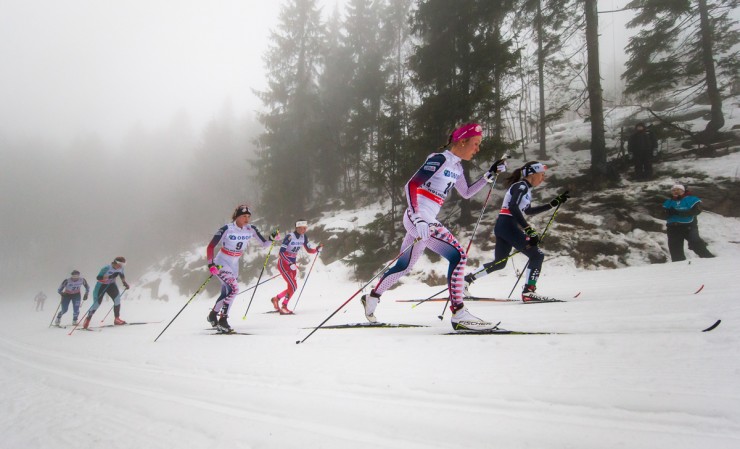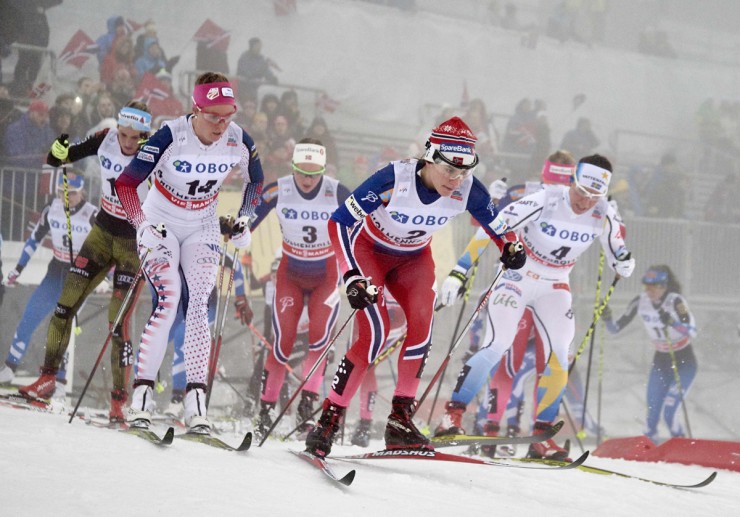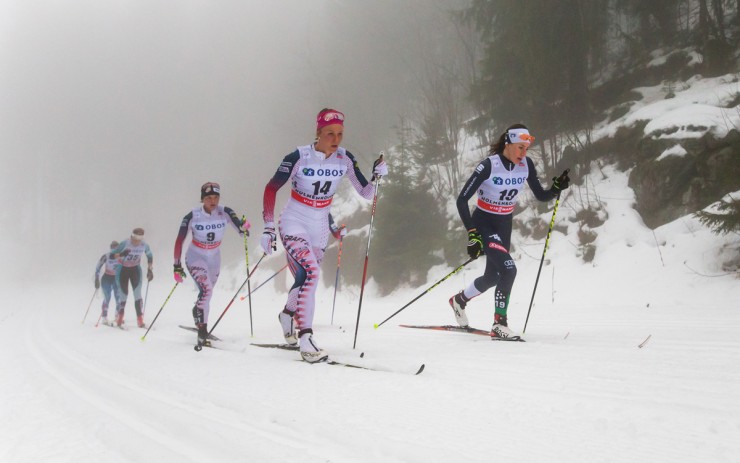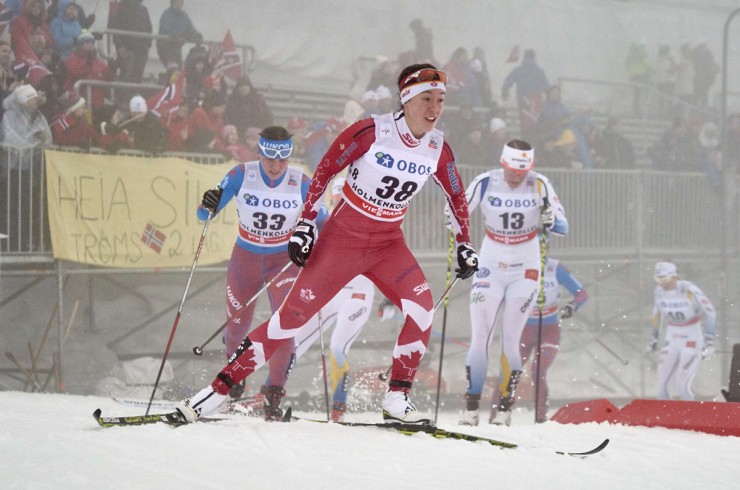
If a 30-kilometer classic mass start on a brutal course wasn’t challenging enough for the U.S. women’s team, which specializes in shorter-distance skate races, the fog and rain made for an even tougher day at the Holmenkollen stadium in Oslo, Norway.
Temperatures hovered around 5 degrees Celsius (41 Fahrenheit) throughout the day and a thick fog enveloped the racers and spectators. Intermittent rain fell through the race on yet another klister day.
“It was just thick, thick fog with maybe 75 feet of visibility. You are completely socked in and soaked,” coach Matt Whitcomb said in a post-race phone interview.
Norway’s Therese Johaug dominated the race, winning in 1:24:55 for her first Holmenkollen 30 k classic title. Her winning margin of 3:46.5 was the largest in the race history for the women. Norwegian Ingvild Flugstad Østberg continued to prove she is a threat in both sprints and distance races, taking second place, 29.5 seconds ahead of Finland’s Anne Kyllönen.

Three American women cracked the top 25 and finished within 1.6 seconds of one another. Sadie Bjornsen led them in 22nd (+7:44.5), closely followed by Liz Stephen in 23rd (+7:45.4) and Jessie Diggins in 25th (+7:46.1).
Rosie Brennan and Caitlin Patterson also represented the U.S., finishing 33rd (+11:43.7) and 36th (+12:09.1) respectively.
Canadian Emily Nishikawa placed 39th (+12:41.1) for her best Holmenkollen result in the last two years at the race.
Reminiscent of Martin Johnsrud Sundby’s aggressive start in Saturday’s 50 k, Johaug pushed early and established an 8.6-second lead just 1.8 k into the race. She widened the gap throughout the race with her characteristic-and-unrelenting quick tempo.
The women’s race started with a 5 k loop before continuing on for three laps of the same 8.3 k loop used in the men’s race. The first loop contained some of the steepest climbs in the course and the women had the challenge of navigating them while still in a large pack.
Bjornsen asserted herself near the front of the large chase pack in the first five kilometers. Diggins also established herself in the top 20 with Brennan not far behind in 26th at the five kilometer mark.
Despite the strong start, over the next five kilometers Bjornsen, Diggins and Brennan were shuffled back as the field strung out, morphing from a pack to solo skiers and small groups.
The dense fog isolated racers from one another, making it difficult to judge gaps and placement in the field — for better or for worse.

“At some point it would have been nice to have the motivation of knowing that there were people within reach ahead, but it was probably also good at other places that I couldn’t see,” Patterson wrote in an email.
Since each 8 k lap climbed over the first three kilometers before a long descent, there was significant movement through the field depending on skis and the racers’ strengths.
“Sadie and Jess had very good kicking skis, but they were not gliding the fastest,” Whitcomb said. “We saw a lot of that in the field — a lot of women slipping and falling back on the climbs and those with slower skis and falling back on the descent.”
Diggins and Bjornsen lost time on the descent and fell out of contact with the chase group of 11 to 15 skiers.
By 10 k, Bjornsen and Diggins were skiing in a tight group of four racers, at 25th and 28th places respectively. Brennan slipped to 33rd, which she maintained for the remainder of the race.
Bjornsen and Diggins’ pack grew to seven racers by the 15.5 k mark, including teammate Stephens who had fought her way through the field after a beneficial ski switch.
“Her first pair of skis were slower and her second pair were really good. We were really hoping for good feelings out there for Liz and she felt great,” Whitcomb said.
At 18 k, Stephen picked up the pace and grabbed places each kilometer putting 11.7 seconds on the group and moving to 21st place within two kilometers. She continued to grab places, managing to reach 18th place by 28.5 k.
In the final kilometer, Bjornsen and several other skiers in the group managed to reel in Stephen, finishing in a tight group with only 15 seconds between 17th and 25th place.
“It was fun to share the majority of the kilometers with Jessie as we pushed each other along, and then chase Liz some there at the end,” Bjornsen wrote in an email.
“Today was one of the more challenging Holmenkollen’s both mentally and physically, but regardless, I still managed to truly enjoy the atmosphere out there while I was racing,” she wrote. “Conditions were challenging the entire race, and our team fought hard to stay in the mix.”
Stephen reflected on her race as “a step in the right direction,” in a U.S. Ski Team press release.
“I have been trying to manage a fatigued body this season and so the last 10 days that we spent training in Sjusjoen, Norway were all about recovery for me,” she said. “I trained slow, worked on some technique and rested more than I wanted to with perfect winter conditions right out the door each day.
“But each day I felt a little better and so today’s feelings were of a body that is much more recovered, has much more energy and spunk in it and I loved the foggy, wet conditions we had today,” she added. “I was mentally ready to charge again and my body responded positively to each push.”

Although the U.S. women put together respectable results on a very challenging day, “We just didn’t hit it out of the park,” Whitcomb said. “We had athletes who had one or two or three great laps but we didn’t have anyone who was able to put together four great laps. So that is why we saw somewhat muted results today.
“We were excited about Caitlin Patterson getting over here for her first big distance race. Finishing 36th is nothing to dismiss for sure,” he added. “We are happy she is feeling good and excited to see what she can do.”
Patterson had to transition abruptly to World Cup level competition and terrain after competing on the domestic SuperTour circuit just last week.
“While in the U.S. someone often drives the pace a little at the beginning of a race to break up the field, it’s nothing like the pace in the World Cup with Johaug leading,” Patterson wrote. “I’m notoriously on the slow side for starting, and even though I knew it was going to begin fast today, it caught me off guard.
“I was frantic at the start, didn’t find the smooth and powerful style of striding that has served me well in other races this year, until well into the race,” she added.
Although she didn’t realize it due to the dense fog, Patterson went through the 2.7 k time check 47th out of 49 starters. However, she was able to find her rhythm and adjust to the demanding terrain and move up to finish 36th.
“The terrain is undoubtedly bigger, steeper, harder than basically anywhere I’ve skied in the U.S. In a classic race this means I have to push my limits, a long steep striding hill that we’d rarely be faced with in the US is very strideable but you have to figure out how to do it,” she wrote.
At the end of the day, Patterson remained positive. “We all have our weaknesses, and you really have to be at the top of your personal race game to have a chance to compete against the best in the world, and I’m as motivated as ever to keep making little steps whenever I can to get there,” she wrote.
World Cup racing resumes with classic sprints Thursday in Stockholm, Sweden, followed by weekend distance races in Falun, Sweden.
Kaitlyn Patterson
New to the FasterSkier team, Kaitlyn is a silent sports all-arounder, competing in cross-country skiing, cycling and triathlon since graduating from the University of Michigan, where she ran cross country and track. Kaitlyn is intrigued by the complexities of cross-country ski racing and is excited to start in the elite women’s field at the 2016 Birkie.



